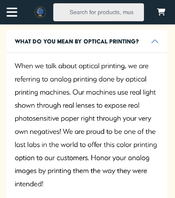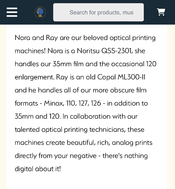DREW WILEY
Member
- Joined
- Jul 14, 2011
- Messages
- 14,575
- Format
- 8x10 Format
To do any of this is a fair objective manner, you'd need to OPTIMIZE any two competing options. The mere mention of an inkjet print means you're going to be knocked out in the first round compared to a well enlarged optical print.
Nikon 2 - you don't have an optical print in any manner whatsoever in what you described, once you have ANY kind of intervening digital workflow involved, which scanning implies. And a tiny cheap 4x6 snapshot sized print sure isn't going to tell you much.
Nikon 2 - you don't have an optical print in any manner whatsoever in what you described, once you have ANY kind of intervening digital workflow involved, which scanning implies. And a tiny cheap 4x6 snapshot sized print sure isn't going to tell you much.









